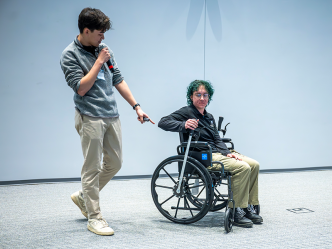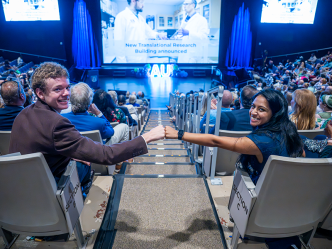One of the toughest parts of working in the medical field is supporting a family in an end-of-life situation. You can’t teach a student what to say out of a textbook, nor is it always practical to use a real-life comfort care situation as a “teaching moment.” But a new collaboration between the College of Nursing and the Center for Instructional Innovation at Augusta University is helping students learn this sensitive subject matter in a safe, controlled environment.
The collaboration is called LIVE, or Learning through Interprofessional Virtual Experiences.
LIVE uses virtual reality to train nurses through end-of-life simulation, which teaches them empathy and helps them practice techniques to better support their future patients and families.
“I’m a palliative care nurse practitioner who came to the College of Nursing because of that expertise,” said Dr. Elena Prendergast, assistant professor of nursing at the College of Nursing. “I realized there was a big gap and we’re not training our future nurses and physicians to do this.”
After discussing her thoughts with Dr. Karen Walton in the Interdisciplinary Simulation Center, they developed a plan to duplicate end-of-life scenarios in virtual reality.
“I think immersing a student in that experience is the best way. The connection was made with Lynsey Steinberg because we think medical illustration could really help with this. But in addition to being a medical illustrator, she deals with innovation in teaching and so that’s where it came together,” added Prendergast.
Usually VR is associated with artificial intelligence and computer-generated environments. But not in this case: In LIVE, end-of-life situations were filmed in the Interdisciplinary Simulation Center with real actors playing both the patient and family members, making the scenarios as realistic as possible.
“We realize that when teaching in empathy, it’s really about perspective,” said Steinberg. “How do you teach somebody about perspective without being able to really put them in a situation that resembles end-of-life cases?”
With the help of faculty facilitators, students participate in debriefing activities designed to assist them with not only learning professional skills but also managing the emotional issues that arise when working with dying patients and their families. The goal is to provide a safe learning space that encourages the development of empathy at end-of-life. Outside of hospice experiences, these educational moments are not often available to students.
Through the VR headsets, students are given three scenarios where they need to support a dying patient’s family and comfort them. Looking a family member in the eye and body language can play a big part in these cases, according to faculty facilitators.
A pilot group of eight students — all in the Master of Science in Nursing with a concentration in Clinical Nurse Leader program — completed the simulated end-of-life experience in early June and were able to provide valuable feedback to the design team.
Steinberg said two of the CNLs went through the experience without prior training in virtual reality, and this made it evident that students in future cohorts should be exposed to the VR experience before entering the simulation, is it can be overwhelming.
“This is just not really something that you would expect to be viewing through a virtual reality headset,” said Steinberg. “When they put it on, and the emotional impact is right there, you are now addressing the situation so it’s fully immersive. You are there with the patient, so this is training in its finest form.”
Prendergast and Steinberg agree this is just the jumping off point of using VR.
At the Center for Instructional Innovation, there are just three VR headsets available for classroom use. They are in need of additional headsets to support over 135 students in the curriculum to provide a more cohesive learning experience.
“I think students realize what an impact on education we’re trying to do here in Georgia and the growth has just exploded, and we’re so excited to be part of it. When you put on the headset, most VR scenarios are trying to put you in the eyes of the patient — and we’re trying to put you in the industry before you get into the industry so you have more experience, and you’ll be the best version of a health professional that you can possibly be,” Steinberg said.
“Honestly we do have a vision of taking this out nationally and internationally. Packaging and adapting it for people that have the same needs that we have found. And then we’d like to generate research as well because empathy is a field that people struggle to teach. I definitely think that between the scholarly parts and disseminating it so other teaching institutions can benefit as well, I think that’s definitely our vision,” added Prendergast.
 Augusta University
Augusta University




